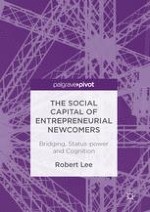2017 | OriginalPaper | Chapter
3. Social Capital: Its Foundations and Application in Management and Entrepreneurship
Author : Robert Lee
Published in: The Social Capital of Entrepreneurial Newcomers
Publisher: Palgrave Macmillan UK
Activate our intelligent search to find suitable subject content or patents.
Select sections of text to find matching patents with Artificial Intelligence. powered by
Select sections of text to find additional relevant content using AI-assisted search. powered by
